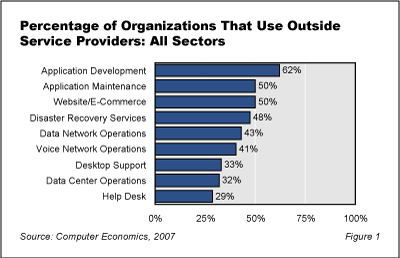The popularity of IT outsourcing is growing. According to Chapter 5 of our latest IT Spending, Staffing, and Technology Trends study, organizations in the U.S. and Canada are increasing the amount of IT work given to outside service providers.
This Research Byte is a summary of our article, The State of IT Outsourcing and Guidelines for Success.
The nine categories of IT outsourcing in our study include the following: application development, application maintenance, website/e-commerce, disaster recovery services, data network operations, voice network operations, desktop support, data center operations, and help desk.
As shown in Figure 1, application development is the most prevalent form of IT outsourcing, with 62% of all organizations in our study reporting the use of outside service providers to do some or all of their application development work. Application maintenance and website/e-commerce are also popular targets for outsourcing, with exactly half of the respondents in our study reporting use of outside service providers. Disaster recovery services and network operations (data and voice) follow, with over 40% of respondents indicating some use of outsourcing.
Only about one third of our respondents report use of outside service providers for desktop support, data center operations, or help desk. However, as we will see later in this article, when organizations do outsource these functions, they tend to turn over larger percentages of the work to the outside service provider.

Changes This Year in the Levels of Outsourcing
The percentages shown in Figure 1 are only slightly different from last year’s, indicating that the number of organizations outsourcing each function for the first time this year is roughly equal to the number of organizations that brought these functions back in-house. Those who are hoping for a reversal of the trend toward IT outsourcing may be cheered by the fact that the number of outsourcing customers is not increasing. However, other statistics show that this good cheer is misplaced.
The full version of this article investigates the prevalence of IT outsourcing for nine IT functions, the percentage of organizations reporting a change this year in their levels of outsourcing for each IT function, and the relative priority that these firms give to outsourcing versus “back-sourcing” (bringing outsourced functions back in-house), using application development and help desk outsourcing as an example. We also explore the concept of “partial outsourcing,” where some work is outsourced while the rest is retained in-house, using application development and help desk outsourcing as examples.
The full version of this article also provides six principles for organizations that are considering the use of outside service providers or planning to change their level of outsourcing, based on our survey data.
In today’s economy and tightening job market, few IT organizations can afford to adopt a “no outsourcing” strategy. On the other hand, outsourcing the entire IT organization to an outside provider is rarely justified. A more sensible approach is to evaluate each IT function in terms of its opportunity for outsourcing and then take a phased approach to apportion a well-defined level of work to the service provider. Based on measured success, the level of outsourcing can then be increased until the organization attains the right balance of internal and external resources.
This Research Byte is a brief overview of our article on this subject, The State of IT Outsourcing and Guidelines for Success. The article is available at no charge for Computer Economics clients, or it may be purchased by non-clients directly from our website at https://avasant.com/report/the-state-of-it-outsourcing-and-guidelines-for-success-2007/ (click for pricing).
For a more complete analysis of the state of IT outsourcing today, please refer to Chapter 5 of our latest IT Spending, Staffing, and Technology Trends study, which provides a comprehensive analysis of adoption trends in IT outsourcing for nine major IT functions: application development, application maintenance, website/e-commerce, disaster recovery services, data network operations, voice network operations, desktop support, data center operations, and help desk. An analysis of the use of offshore service providers is also documented. Click here for more information on this Chapter on IT outsourcing, including pricing.

